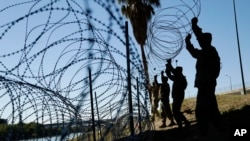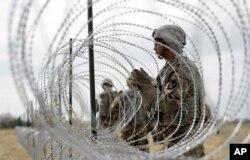The Pentagon is preparing to send additional troops to the U.S.-Mexico border, even as some members of Congress question the appropriateness of deploying troops there.
Acting Secretary of Defense Patrick Shanahan told reporters Tuesday that "several thousand" active U.S. troops likely will be assigned to the border. Shanahan said that the move is in response to a Department of Homeland Security (DHS) request related to placing concertina wire.
There are currently about 2,300 active troops at the border, Under Secretary of Defense for Policy John Rood told the House Armed Services Committee on Tuesday. The number is down from a high of 5,900 at the end of last year.
The committee's hearing into President Donald Trump's original decision to send troops to the border came as Congress and the president work to resolve their differences over construction of a wall on the southern border. Trump says he must have $5.7 billion for the wall, while House Democrats have held firm on zero funding for a wall. The two sides have until Feb. 15 to come to an agreement, when short-term funding for much of the U.S. government expires.
"To date, the impact of [the troops'] deployment isn't fully understood nor has there been a full justification for why the administration subsequently diverted active duty personnel to the border or details regarding when that deployment will end," Committee Chairman Adam Smith, a Washington Democrat, said in his opening statement. "Moreover, the deployments to the border seem to conflict with the department's stated efforts to rebuild readiness."
Vice Admiral Michael Gilday told the committee that the troops have made a difference. Laying concertina wire "hardened those ports of entry," he said, allowing Customs and Border Protection to use its manpower more efficiently.
Gilday said the decision to deploy active troops was made by the Department of Defense because they could deploy faster than National Guard reservists and because the Guard was not skilled in laying concertina wire.
As far as future readiness is concerned, Gilday said some units have missed or will miss company-level training, but the Defense Department believes they can recoup.
The cost of the deployment of active troops has been $132 million since they were first called up last fall until the end of January, while deployment of the National Guard to the border is estimated at $550 million from last April through the end of 2019, Gilday said.
Rood told the committee that DHS is tracking three caravans moving toward the U.S.-Mexico border, one estimated at more than 12,000 members.
"We have to be more flexible to respond to changing circumstances. I think that is what the president is trying to do," said Congressman Mac Thornberry, a Republican from Texas. "I would prefer not to use the military ... but things change."
Steve Herman contributed to this report.










